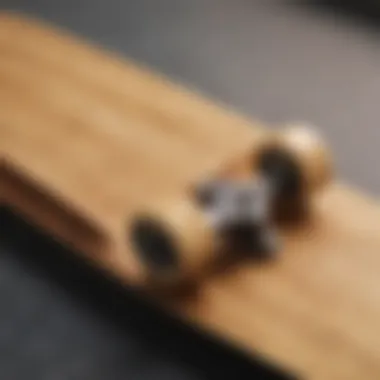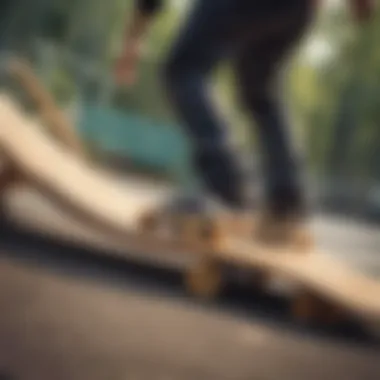Bamboo Boards and Skateboarding: A Sustainable Trend


Intro
The emergence of bamboo skateboards is not just a fleeting trend; it hints at a broader cultural shift towards sustainability within skateboarding. As skaters continue to seek environmentally friendly alternatives to traditional materials, the allure of bamboo grows. Incorporating both unique aesthetics and potential performance benefits, bamboo skateboards stand out in an industry dominated by maple. This exploration dives into how bamboo boards impact the sport, while also reflecting a growing awareness of environmental conservation.
Skateboarding, often seen as just a recreational activity, plays a pivotal role in various social movements, especially in advocating for sustainability. Underneath the veneer of tricks and flips lies a community that’s increasingly concerned with the materials they use and their overall impact on the planet.
In the sections to follow, we will delve into the construction of bamboo skateboards, their performance characteristics compared to traditional maple, and discuss the environmental implications of choosing bamboo as a skateboard material. Additionally, we will highlight significant brands that embrace this innovation and identify challenges faced by bamboo enthusiasts.
This detailed examination caters to a diverse audience, including skateboarders, educators, and eco-conscious content creators eager to understand the intersection of skateboarding culture and environmental practices.
Tricks and Techniques
Moving through tricks such as heelflips and kickflips on a bamboo board presents a unique sensation than on conventional wooden decks. The flexible nature of bamboo introduces a different feel—its responsiveness can alter the way maneuvers are executed and landed.
Mastering the Heelflip
The heelflip is one of skateboarding's foundational tricks, involving a flick of the foot to rotate the board. On a bamboo skateboard, the flexibility can enhance the pop, allowing for a cleaner lift off the ground. To master this trick, skaters should follow these steps:
- Foot Placement: Place your back foot on the tail for maximum leverage. Your front foot needs to sit near the middle and angled slightly.
- Pop and Flick: As you pop, drag your foot up with intention. Instead of a toe flick, you will use your heel to initiate the spin.
- Catch and Land: Keep your eyes on the board as it flips and catch it with your back foot to land gently.
With practice, skaters can find the bamboo skateboard enhances their progress in tricks like these, thanks to its distinctive properties.
Tips for Consistent Landings
The secret to nailing landings consistently on a bamboo skateboard lies in understanding its quirks. Here are some simple tips:
- Stay Committed: The mindset you carry while committing to tricks is crucial. Hesitation often leads to missed opportunities for landing.
- Practice Foot Placement: Allowing yourself to adjust foot positioning depending on how the board reacts in the air can optimize control.
- Core Strengthening: Maintain strength by incorporating core stability workouts into your routine, enhancing balance and control during tricks.
In the skateboarding world, practicing and refining these skills not only adds to a skater's repertoire but also demonstrates the adaptability of bamboo boards in trick execution.
Skate Gear and Equipment
Choosing the right skateboard becomes even more significant when one considers bamboo's growing presence in the market. Skaters need to think beyond style and consider performance, comfort, and environmental impacts of their choices.
Choosing the Right Skateboard
When weighing options between bamboo and traditional materials like maple, skaters should consider:
- Weight: Bamboo boards are typically lighter, making them appealing for tricks, while still packing a strong punch for durability.
- Flexibility: This characteristic can enhance responsiveness, but finding the balance between flexibility and control is key.
- Shock Absorption: Bamboo's natural shock-absorbing properties may appeal to those looking for smoother rides on rough terrains.
Essential Safety Gear for Skaters
Regardless of the board material, protecting oneself is non-negotiable when skating. Essential safety gear includes:
- Helmet: For head protection, always use a skateboard-approved helmet.
- Pads: Knee and elbow pads reduce the risk of scrapes and bruising.
- Shoes: Opt for skate-specific footwear that provides grip and comfort.
Adopting bamboo skateboards offers not just a refreshing perspective on design but also contributes to a more sustainable approach to skating, aligning with evolving values across the skateboarding community.
Epilogue
With bamboo skateboards making waves, skaters are not simply choosing a different type of board—they are participating in a cultural movement that emphasizes environmental awareness. Exploring the attributes and techniques associated with these boards unveils a dynamic interplay of culture, performance, and sustainability. As the industry evolves, skaters can play a crucial role in advocating for eco-friendly practices, paving the way for a greener future in their sport.
Skateboarding is not about the destination; it's about the journey, and with bamboo skateboards, that journey is making waves in promoting sustainability.
Prolusion to Bamboo Skateboards
Bamboo skateboards have stirred a conversation in the skateboarding world lately. The topic dives deep into how materials can shape performance, sustainability, and even the culture surrounding skateboarding. As skateboard enthusiasts search for alternatives to traditional materials, bamboo offers a fresh perspective thanks to its unique properties.
Defining Bamboo Boards
A bamboo skateboard is primarily made from bamboo, a grass known for its incredible strength despite being lightweight. It’s often laminated with other materials, such as epoxy, to enhance durability and performance. What sets bamboo boards apart from their wood counterparts, like maple, is that they tend to have a more forgiving flex. The flexibility of bamboo boards allows for smoother rides and better impact absorption—key features for skaters tackling various terrains.
Many might wonder about the construction process. Manufacturing a bamboo board typically involves layering strips of bamboo in a certain orientation to maximize strength. This layering technique creates a composite that is both resilient and adaptable to a rider's movements, allowing for more dynamic skating.
Historical Context of Skateboarding Materials
To truly appreciate bamboo skateboards, it’s essential to understand the historical development of skateboard materials. Skateboarding began in the late 1940s and early 1950s, primarily with wooden boards made from maple. Maple's density and strength made it the go-to choice for skaters. Over the years, as the sport evolved, manufacturers sought to innovate with new materials—plastic and composite materials made their way into the scene.
Yet, the resurgence of environmentally-friendly practices led to a shift back towards more sustainable options. That’s where bamboo comes into play. Unlike traditional woods, bamboo matures rapidly, making it a renewable resource. As both skaters and the public become more aware of environmental impact, this shift toward bamboo represents both a nod to new trends and a return to natural materials.
"The materials we choose in skateboarding can shape not just our rides but the very culture we inhabit."
In combination with a general push for sustainability, bamboo skateboards provide an exciting new alternative that strives to balance performance and environmentally-conscious choices. As this trend grows, it’s vital for skaters and retailers to engage with the reasons behind the materials they choose.
Material Properties of Bamboo
Understanding the material properties of bamboo is key to appreciating its place in the skateboarding world. Bamboo isn't just any wood; it's a grass whose unique structure grants it remarkable qualities. This section digs into what makes bamboo a standout choice for skateboard construction, spotlighting its strength, flexibility, and how it stacks up against traditional materials, particularly maple.
Strength and Flexibility
Bamboo's strength is often surprising to those who haven’t encountered it before. In fact, it can be stronger than steel when stretched over larger spans. This strength doesn't come at the cost of rigidity; instead, bamboo offers an exceptional amount of flexibility as well. This balance creates a dynamic ride that so many skaters find appealing.
One of the standout features is the ability of bamboo boards to absorb shock, which improves comfort during rides. Whether you are zipping through the streets or carving up a park, this flexibility helps to reduce strain on skaters' legs, allowing for longer sessions without as much fatigue.
Beyond comfort, this capacity for flex also factors into tricks and maneuvers. Bamboo boards can adapt underfoot, reacting more responsively and providing a lively feel that skaters often describe as springy. The physics behind bamboo’s structure plays a significant role here. The fibers run in different directions, enabling a unique recoil effect that can enhance flip tricks or sharp turns.


Thus, if a skater is searching for a board that both performs well and feels comfortable, bamboo certainly deserves a close look.
Weight to Strength Ratio
One cannot overlook the weight to strength ratio that bamboo boasts, distinguishing it from its competitors. Typically, this ratio is essential for skaters because a lighter board can be easier to handle, especially for tricks. But while many lightweight boards compromise on strength, bamboo defies that convention.
A bamboo skateboard can weigh significantly less than equivalent maple boards without sacrificing durability. This lightness translates directly to performance—increased ollies, smoother flip tricks, and an overall ease of maneuverability are seen as benefits when riding a bamboo board.
In practical terms, this means skaters can spend less energy getting their boards in the air and more time focusing on their moves. For example, when attempting complicated tricks, less weight can lead to better control and precision, making rush hour stunts or casual street skating alike more enjoyable.
To sum things up, bamboo skateboards offer an impressive weight to strength ratio, making them accessible for skaters across various skill levels, from beginners to seasoned pros.
"The material choice can define your skate experience, and bamboo stands out for its unique ability to blend weight, strength, and flexibility."
For anyone considering a bamboo board, it's essential to look at these properties closely. Not only do they contribute to how a board rides, but they also reflect a larger trend towards innovative materials in a sport that thrives on evolution.
Sustainability of Bamboo as a Material
In the realm of skateboarding, sustainability is becoming more than just a trend; it's morphing into a crucial aspect of how boards are produced and the materials utilized. Bamboo boards stand out distinctly in this regard. They offer a window of opportunity to harmonize skate culture with eco-consciousness. As skateboarding grows in popularity, acknowledging the environmental footprint of this sport has never been more vital. Not only does bamboo outshine traditional materials like maple in terms of sustainability, but it also invites skaters to engage in a broader dialogue about their environmental responsibilities.
Renewable Resource
Bamboo is often hailed as a renewable resource, primarily due to its rapid growth cycle. Unlike hardwoods that may take decades to mature, bamboo can reach its full height in a matter of months. This rapid regeneration rate makes it an appealing alternative for skateboard production. When harvested responsibly, bamboo can be replenished much quicker than its hardwood counterparts. This unique characteristic effectively lowers the demand on forests, reducing deforestation and encouraging a more sustainable ecosystem.
Skaters can appreciate that every bamboo board supports a cycle that benefits the planet. Additionally, bamboo absorbs more carbon dioxide and releases more oxygen than many tree species, contributing positively to air quality. For skaters who are environmentally inclined, these factors add a layer of satisfaction to their choice in boards, knowing they are contributing to a greener footprint.
Environmental Impact Comparison
Comparison to Maple and Other Woods
When comparing bamboo to traditional materials such as maple, differences in sustainability become apparent. Maple offers strength and durability, but its long growth time and the deforestation associated with its harvesting present significant environmental concerns. The logging processes often lead to habitat loss and biodiversity decline. On the other hand, bamboo, with its rapid growth and minimal replanting requirements, allows for a more sustainable approach to production.
Key characteristics of bamboo make it a popular choice among environmentally conscious skateboarders. Its natural fibers provide both flexibility and strength, enhancing performance without the ecological cost commonly associated with traditional woods. The choice of bamboo reflects a shift towards prioritizing sustainability in skateboarding. This is not only beneficial for the environment but also supports a culture of awareness among skaters.
- Advantages of Bamboo:
- Disadvantages of Maple:
- Rapid growth: can be harvested in 3-5 years.
- Better carbon absorption rates compared to maple.
- Less resource-intensive production.
- Takes decades to mature for harvest.
- Associated logging practices can be harmful to ecosystems.
With these comparisons, it's clear that bamboo offers a robust alternative, aligning performance expectations with ecological mindfulness.
Carbon Footprint Analysis
Understanding the carbon footprint of bamboo skateboards versus those made from maple involves examining several factors, including production, transportation, and end-of-life disposal. Bamboo generally has a reduced carbon footprint largely because of how it grows and is processed. Its ability to grow quickly means that land degradation is minimized, as less area is required to yield the same amount of material.
Bamboo boards not only have a smaller carbon footprint during their lifecycle, but they also contribute positively by absorbing CO2 while they grow. This productive phase can significantly outclass that of traditional wood production, which often relies on expansive resource jobs.
Furthermore, the end-of-life disposal of bamboo can often be more sustainable than that of traditional skateboards. Bamboo can decompose more easily compared to synthetic materials or glues commonly used in maple production, promoting a more eco-friendly disposal process and reducing landfill contributions.
- Key Features of Carbon Footprint Analysis:
- Lower emissions during growth and production.
- Contribution to carbon offsetting while in use.
- Natural decomposition in comparison to synthetic alternatives.
As skateboarding continues to evolve, bamboo is paving the way for a greener future, urging skaters to rethink the materials beneath their decks and the implications of their choices on the planet.
"Choosing bamboo is not just a matter of style; it’s a commitment to bettering our planet. Each board tells a story of renewal, growth, and environmental stewardship."
In summation, bamboo's sustainability as a material opens doors not only for innovation in skateboard construction but also for changes in how we perceive our role as skaters in today's world.
Comparative Analysis: Bamboo vs. Maple
While bamboo skateboards are carving a niche in the skateboarding world, it’s essential to understand how they stack up against the traditional maple boards, which have long been the go-to for skaters. This comparative analysis provides a nuanced view of the two materials, highlighting specific elements that may influence a rider’s choice and ultimately shape their skateboarding experience.
Bamboo’s unique properties coupled with its sustainable nature create a compelling alternative to maple, yet both materials present distinct advantages and challenges that deserve careful consideration.
Durability and Longevity
When it comes to durability, bamboo boasts impressive strength that often surprises new users. It has a natural flexibility that can absorb shocks better than maple, which can help prevent snap-offs during tricks or hard landings. However, this flexibility comes with a caveat; over time, extended use on rough surfaces can impact the structural integrity of bamboo boards, leading them to wear down faster than their maple counterparts.
Maple, on the other hand, is known for its rigidity and is generally regarded as less prone to warping or deteriorating over time. This makes it the favored choice for more aggressive riding styles. A well-maintained maple skateboard can last several years, providing consistent performance across all types of conditions.
In summary, while bamboo offers decent durability, skaters prioritizing longevity might lean towards maple, especially if rigorous use is anticipated.
User Experience: Riding Differences
Feel and Control
The feel and control of a skateboard heavily influence the rider's connection with their board. Bamboo boards often deliver a smoother ride and a more forgiving flex that allows for a subtle feedback during tricks and turns. This responsive nature can make tricks feel more fluid, and riders often report increased confidence when attempting new maneuvers.
On the flip side, maple boards tend to offer a stiffer ride, which can translate to a more direct feel on the pavement. Experienced riders might prefer this stiffness as it can enhance the precision of control during high-speed runs or technical execution of tricks.
In essence, the choice between the two materials often boils down to personal taste, with bamboo providing a relaxed ride while maple caters to those who thrive on responsiveness and precision.


Performance on Various Surfaces
The performance of bamboo skateboards varies significantly based on the riding surface. On smooth surfaces, bamboo boards excel, providing a comfortable glide and excellent handling. The natural imperfections of bamboo can sometimes create a unique feel that enhances the ride, making it particularly enjoyable in parks or on streets kept in good condition.
However, when it comes to rougher surfaces or more abrasive terrains, maple boards shine through. Their solidity offers better stability, making them less susceptible to bumps and jolts. Many skaters find that maple boards provide a more reliable experience during challenging sessions on various urban terrains.
Ultimately, choosing the right board depends on where you plan to skate. While bamboo has its merits, especially in cleaner environments, maple often proves its worth in tougher conditions.
"Understanding the nuances of riding differences between bamboo and maple is crucial for skaters looking to find their perfect board."
In summation, the comparative analysis of bamboo and maple skateboards reveals that both materials bring unique qualities to the table. Riders should weigh important aspects like durability, riding feel, and surface performance to determine which type of board best aligns with their skating style and environmental conditions.
Skateboard Design and Customization
The realm of skateboard design and customization plays a pivotal role, especially when it comes to bamboo boards. With a unique set of properties and considerations, these boards offer not just a practical means of transport but also a canvas for personal expression. This section will delve into the distinctive elements that set bamboo boards apart and explore how riders can tailor these boards to match their style and needs.
Design Elements Unique to Bamboo Boards
Bamboo skateboards are not just about performance; they're also about aesthetic and functionality woven together. One standout feature is the natural grain and color variations of bamboo. Unlike traditional maple boards, bamboo can present a diverse palette that showcases each board's individuality.
- Sustainability in Design: The natural look of bamboo provides a rustic yet modern feel, making it appealing to eco-conscious riders. This design ethos connects directly with a burgeoning market that values sustainability alongside style.
- Layering Technique: Manufacturers often use a layering technique, where thin strips of bamboo are pressed together. This approach not only boosts durability but also adds a unique touch to the board's appearance.
Customization Options
Customization is an art in itself when it comes to skateboards, particularly bamboo ones. Skaters crave individuality, and bamboo boards can cater to this desire effectively.
Artistic Designs
Artistic designs breathe life into bamboo boards in ways traditional graphics oftentimes can’t achieve. The key characteristic here is natural integration. Bamboo absorbs paint and ink differently, allowing for vibrant colors that may seem muted on other materials yet appear rich and deep on bamboo.
This quality not only enhances the visual appeal but can also resonate with the skate culture’s focus on personal stories and narratives. Riders often opt for custom paintings or graphics that reflect their personality, experiences, or social messages.
- Advantages: This leads to a more personal connection and could even invoke curiosity amongst fellow skaters, bridging conversations about art and culture.
- Disadvantages: However, care must be taken, as overly detailed designs could also affect the structural integrity, particularly if the paint is thick or the finish is not done properly.
Board Shapes
The shape of a board impacts not just its look but also how it performs. Bamboo boards come in various shapes tailored for different skating styles. This variety is a significant aspect of customization.
One key feature is the concave design, which helps skaters perform tricks with more ease and control. Custom shapes cater to different disciplines—be it street skating, cruising, or downhill racing.
- Benefits: Riders can seamlessly transition between different styles, reflecting their personal preferences and skating techniques.
- Challenges: Yet, not all shapes are compatible with every rider’s skill level, leading to a potential mismatch between ambition and ability. Some users might find specific shapes limit their abilities or alter the board's responsiveness.
"Choosing the right design and shape is fundamental for not only individual style but also performance in skating. A well-chosen bamboo board can be both art and performance tool."
In summary, skateboards made from bamboo provide a unique canvas for self-expression while balancing practicality. The elements associated with their design and the potential for customization align well with the skate culture’s ethos of individuality and innovation. With each board crafted, skaters are excited to personalize their rides while supporting sustainable practices.
Popular Bamboo Skateboard Brands
The rise of bamboo skateboards has opened up a new avenue for skaters who value both performance and environmental responsibility. In this section, we will explore the realm of popular bamboo skateboard brands, their unique offerings, and how they contribute to the overall landscape of skateboarding.
Brand Profiles: Overview
Company Histories
When you dig into the histories of many bamboo skateboard brands, such as Landyachtz and Bamboo Skateboards, you'll uncover a tapestry woven from passion and innovation. Landyachtz, founded in the mid-1990s, has been a staple in skateboarding, initially focusing on maple boards and gradually branching into eco-friendly materials like bamboo. This transition exemplifies a willingness to adapt and a recognition of the importance of sustainability in today’s market. On the other hand, Bamboo Skateboards made its mark specifically by emphasizing bamboo from the get-go. Their commitment is apparent not just in their product but also in their branding, which often highlights a connection to nature. This unique feature of focusing solely on bamboo has allowed them to create niche products that cater specifically to eco-conscious skaters.
Market Position
The market position of bamboo skateboard brands varies but often reflects their commitment to sustainability and innovation. For instance, Bamboo Skateboards tends to appeal to a demographic that prioritizes environmental concerns, as it's primarily marketed toward eco-friendly consumers. Their position as a leader in the bamboo segment allows them to carve out a significant niche amidst the predominantly maple offerings. Landyachtz, while still a leader in the traditional skateboarding space, has embraced the bamboo trend as well, which showcases its flexibility in market positioning. They balance between classic materials and new sustainable technologies, catering to a broad range of skaters—from the purists to environmentally-conscious riders.
Notable Models and Features
Performance Reviews
Performance reviews serve as a critical gauge for assessing the quality and rideability of different bamboo skateboard models. Skaters often report that bamboo boards, like the Landyachtz Bamboo Pinner, offer a unique ride that blends flexibility with stability. This board's construction allows it to absorb shocks from rough surfaces better than traditional maple alternatives, enhancing the overall experience. Moreover, their lighter weight can contribute positively to tricks and maneuverability, something many skaters appreciate. Reviewers often fall in love with how well these boards perform in various conditions, showing that they truly can stand toe-to-toe with classic models.
User Feedback
User feedback is invaluable when it comes to understanding the pros and cons of bamboo skateboards in the field. Many skaters praise the Bamboo Skateboards Mini Cruiser for its smooth ride and eco-friendly essence. Users often appreciate the grip and comfort these boards provide, claiming they feel more connected to the ground, which can elevate their skating. However, some feedback points out that bamboo boards can exhibit a different flex pattern than traditional maple boards, which may take some getting used to for those accustomed to the latter. This transition phase is an important consideration that potential buyers should keep in mind; not all skaters will adapt to the nuances of bamboo right away.
"The ride of a bamboo board is a nature lover’s dream, merging performance with planet-preserving principles." - Expert Skater
In summary, delving into the world of popular bamboo skateboard brands brings forth a wealth of knowledge regarding their unique histories, market positioning, performance reviews, and user feedback. It’s these multifaceted elements that help inform skaters as they navigate the choices in the ever-changing landscape of skateboarding.
Innovation and Future Trends in Bamboo Skateboarding
The skateboarding world is continually evolving, and bamboo skateboards are riding the wave of this change. As we delve into the innovation and future trends surrounding bamboo within the skateboarding community, we uncover not just its unique physical attributes, but also how it's shaping the culture and pushing the boundaries of what a skateboard can be.
Bamboo's lightweight and resilient nature makes it a strong candidate for various design innovations. For instance, advancements in the way bamboo is processed and engineered can lead to enhanced performance through tailored flex and responsiveness. Skaters are always looking for that sweet spot between durability and maneuverability, and bamboo seems to fit that bill.
Moreover, many brands are experimenting with hybrid materials. For example, integrating bamboo with other natural or even synthetic materials can help optimize its performance, creating boards that are not only eco-friendly but also high-performing. This type of approach is vital as skateboarders increasingly desire boards that reflect both their personal style and values.
Technological Advancements


The technology used in the design and production of bamboo skateboards is advancing at a rapid pace. One notable area is the use of computerized cutting and molding techniques that allow for more precise designs. This technology means that manufacturers can create boards that cater specifically to different skating styles—be it street, vert, or perhaps even down-hill skating.
Additionally, the rise of environmentally friendly resin systems is significant. These resins, often derived from natural sources, help to bond the layers of bamboo securely while minimizing harmful emissions typically associated with traditional boards.
By embracing these technological improvements, the bamboo skateboard market is not just about retaining its natural essence, but also ensuring it meets the high demands of modern skaters.
Influence of Skate Culture on Material Adoption
Community Acceptance
Community acceptance plays a central role in how bamboo skateboards secure their place in the broader skateboarding landscape. Over the years, skaters have shown a willingness to embrace materials that align with their ethics and values. This reflects a larger societal trend toward sustainability and responsible consumption. As more skate parks showcase bamboo boards, skaters often share their experiences on platforms like Reddit and Facebook, thereby influencing others.
A key characteristic of community acceptance is grassroots advocacy. Local skaters promoting bamboo boards during meets or competitions, and sharing their positive experiences can lead to a ripple effect. The conversations and interactions in these circles are vital in broadening the appeal of bamboo alternatives in the market.
The Role of Eco-Consciousness
When discussing the role of eco-consciousness in bamboo skateboards, it's evident that sustainability isn't just a buzzword; it has become a lifestyle and a significant factor influencing consumer behavior. Today's skaters are increasingly aware of the environmental impact of their choices. A major characteristic of this trend is the demand for products that are biodegradable or recyclable.
The unique feature of eco-consciousness lies in the transparency of production methods. Consumers appreciate brands that openly share their sourcing practices and the environmental footprint of their products. This not only builds trust but also aligns the skateboard brand with larger environmental movements, thereby enhancing its appeal.
In summary, the intersection of technological advancements and the ethos of skate culture creates a fertile ground for bamboo skateboarding to flourish. As innovations continue to unfold, combined with a strong community that values sustainability, bamboo boards not only stand to gain traction but also promise to revolutionize the way skaters engage with their environment.
Challenges of Bamboo Skateboards
In the realm of skateboarding, bamboo boards are becoming a point of discussion not just for their eco-friendly properties but also for the hurdles they present. Understanding these challenges is essential for skaters who may be considering this innovative material. Each skateboard possesses its own distinct characteristics, and those made from bamboo are no exception. They have specific limitations, which can affect performance and user experience. Additionally, there's a significant conversation happening within the skating community regarding their acceptance in mainstream culture. In this section, we will delve into these two main aspects: performance limitations and market perception, dissecting each to reveal a fuller picture.
Limitations in Performance
Bamboo skateboards are often praised for their lightweight nature, but this same feature can sometimes lead to performance drawbacks. While certain riders might cherish the nimbleness that bamboo offers, others may find it less stable during high-speed maneuvers or technical tricks.
A key aspect is the stiffness of the board. Bamboo does have impressive elasticity, yet it might not provide the same kind of snap or rigidity that seasoned skaters are used to with traditional maple boards. This can create a learning curve for riders transitioning from wood to bamboo—a sort of adjustment that can be frustrating for some.
Additionally, the surface grip on bamboo boards can be a trade-off when compared to more established alternatives. Riders often seek boards that provide the best grip on various surfaces, and the choice of grip tape or the board's finish can significantly impact performance. The lightweight nature could also lead to a reduced ability to handle heavy impacts, making them less suitable for aggressive riding styles.
Market Perception
Understanding how bamboo skateboards are viewed in the marketplace provides insight into their integration within the skating culture.
Challenges in Mainstream Acceptance
The mainstream acceptance of bamboo skateboards faces definite roadblocks. Most skaters still lean towards traditional materials like wood, stemming from deeply rooted habits and preference for tried-and-true equipment. Many shops stock predominantly maple boards, leaving bamboo options as a rarity. This lack of availability restricts potential buyers from experiencing the benefits firsthand.
Additionally, perception often plays a huge role. Some skaters may view bamboo skateboards as a gimmick rather than a serious contender. Even those curious about bamboo may hesitate to invest without sufficient information or real-world performance reviews to guide their decision. In this light, bamboo boards can be seen as an underdog, stymied by pre-existing biases.
Debates in the Skating Community
Within skate culture, there are passionate debates about various materials, including bamboo. Some enthusiasts champion its renewable characteristics and resilience, while others express skepticism over its performance, calling into question its authenticity compared to wood options.
These discussions often highlight a critical intersection of technology and tradition. While using bamboo aligns with eco-conscious initiatives, the risk here is overpromoting its benefits without addressing concerns. Balancing the appeal of an innovative material with realistic expectations is vital for building credibility among skaters. An interesting aspect is that while some ride bamboo to make a statement about sustainability, others remain firmly entrenched in their old-school preferences.
"Every time you step onto a board, you’re not just riding, you’re joining a community, and every choice reflects on that."
In summary, the challenges surrounding bamboo skateboards are complex. While they carry potential and promise in terms of environmental benefits, they also bring limitations in performance that cannot be overlooked. The perception of bamboo within the market and the broader skating community plays a significant role in determining its future. By understanding these facets, skaters can make informed decisions when considering bamboo boards as part of their setup.
Consumer Considerations
Understanding what to look for in a bamboo skateboard is crucial, especially for those who are venturing into this realm for the first time. Skateboarders and enthusiasts alike must navigate an array of options, each with distinctive qualities that could affect performance and longevity. Factors like construction quality, dimensions, and design aesthetics all play a significant role in the buying decision.
When considering a bamboo skateboard, it’s vital to assess how the material affects the overall ride. Different boards can present a varied feel based on their flex, stiffness, and how many plies of bamboo are used. Moreover, whether the board is designed for cruising, tricks or downhill rides can also influence the need for specific features.
What to Look for in a Bamboo Skateboard
Here are key elements to ponder when selecting a bamboo skateboard:
- Material Quality: Always ensure the bamboo used is high-grade. This will often mean checking how many layers of bamboo are used in the construction. A higher ply count usually results in a stronger and more flexible board.
- Board Shape: The shape affects performance. A wider board may provide better stability for beginners, while a narrower board could offer more agility for skilled riders.
- Graphic Options: Look for artistic designs that resonate with your aesthetic. Bamboo boards often feature unique, eco-friendly graphics that stand out.
- Grip Tape: Quality grip tape is essential for safety. Make sure it provides enough traction for confident maneuvers.
- Brand Reputation: Researching brands can provide insights into durability and customer satisfaction. Opt for brands known for their quality and customer service.
Before purchasing, testing different boards can help ensure you find the right fit. Feel free to check out local skate shops or skate parks where you might find opportunities to demo various models.
Price Points and Value Assessment
When purchasing a bamboo skateboard, understanding price points alongside value is vital. Generally, prices can range quite a bit, often influenced by the brand, technology, and unique design elements of the skateboard.
- Entry Level: Bamboo skateboards typically start around $100, which may be suitable for casual riders or beginners looking to test the waters without breaking the bank.
- Mid-Range Options: Expect to pay about $150-$250 for boards that offer good quality, perhaps with specialized features geared towards more serious skaters.
- Premium Models: High-end boards can be priced upwards of $300, often incorporating advanced technology, exceptional craftsmanship, and distinctive designs.
When determining value, consider the longevity of the board. Investing in a well-built bamboo skateboard can provide better performance and save money in the long run by eliminating the need for early replacements. Customer reviews and performance feedback can illuminate how different boards hold up over time.
In summary, being informed about what to look for and the price-to-value correlation in bamboo skateboards not only enhances the buying experience but also ensures a well-considered choice that aligns with your skating style and budget.
Epilogue
Bringing everything together, the exploration of bamboo skateboards reveals a fascinating intersection of sustainability and performance. This article has highlighted several important elements, such as the unique properties of bamboo, how it compares to traditional materials like maple, and the broader cultural significance of skateboarding within ecological movements. Through these discussions, readers can appreciate the multifaceted nature of bamboo boards, offering deeper insight for skaters at all levels.
Recap of Key Points
- Material Characteristics: Bamboo's remarkable strength and flexibility make it an attractive alternative to traditional skateboard materials. Its lightweight nature contributes positively to riders' performance, offering a distinct feel.
- Sustainability Aspects: Bamboo is a rapidly renewable resource, which contrasts sharply with slower growth hardwoods. Understanding its lower carbon footprint will resonate with eco-conscious skaters.
- Market Dynamics: The various brands that have emerged in the bamboo skateboard arena are redefining the industry, highlighting user experiences and innovative designs that cater to skaters’ preferences.
- Challenges Renowned: Even as bamboo gains popularity, certain challenges persist. Market perception of its performance compared to traditional materials remains a consideration for consumers.
Final Thoughts on Bamboo Boards in Skate Culture
As skaters ponder over their choice of boards, bamboo represents more than just an alternative material; it signifies a move toward environmentally responsible practices in skateboarding. The embrace of bamboo boards showcases how the sport is evolving, particularly in relation to sustainable living. By adopting bamboo, skateboarders not only enhance their riding experience but also support a movement that prioritizes environmental stewardship. As this trend continues to gather momentum, it will further intertwine skate culture with a commitment to the planet, encouraging future innovations in skateboard manufacturing.



